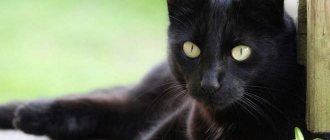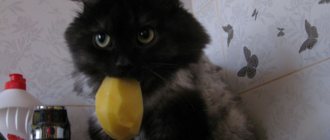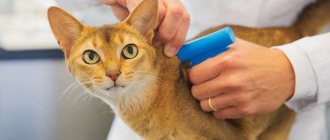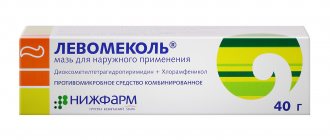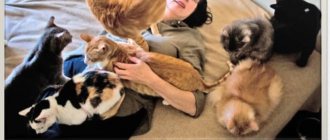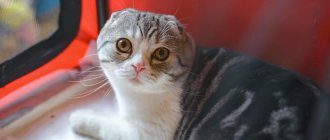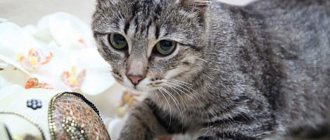The question of whether a cat has a belly button is both interesting and provocative. People far from biology assume that animals are completely devoid of this anatomical feature, especially since it is not easy to detect. But don’t be fooled: knowing about the class affiliation of felines, as well as the process of development and birth of offspring, it will not be difficult to guess the correct answer.
A little about cat physiology
There is no doubt whether cats have a belly button. According to the school zoology course, all placental mammals have it.
Purpose of the umbilical cord
Before it is born, the embryo is connected to the uterus through the umbilical cord. From it he receives oxygen and important nutrients. The umbilical cord also filters waste products, returning them back to the mother. It is her body that brings them out.
Do kittens have an umbilical cord?
It remains to be seen whether kittens have an umbilical cord after birth. At birth, all newborns are surrounded by a placenta, or afterbirth. It contains a large number of useful microelements, so the cat eats it. At this point, she bites the umbilical cord connecting the kittens to the placenta.
At the site of damage, a stump and a small wound appear, which the new mother must lick. The lysozyme contained in her saliva acts as an antiseptic and accelerates the process of tissue regeneration.
4-7 days after birth, the stump dries out and falls off. The umbilical ring grows together, and in its place a slightly convex and clearly visible bright pink spot forms.
What does the belly button look like on an adult cat?
Within a month, a small round or oval scar becomes lighter and is overgrown with new hair. Unlike humans, the navel of mature mustachioed pets is practically invisible and does not have a characteristic convex shape. This is due to the absence of the umbilical cord tying stage.
Physiological significance
Knowing your pet's physiology is no nonsense. Only through knowledge can you save your beloved animal from many health-related troubles - the same hernia, for example. We must not forget that self-diagnosis is not a solution at all, since the cat’s owner lacks qualifications, as a result, traces of the umbilical cord will seem like a catastrophic phenomenon.
3 Reasons Why Your Cat Loves to Eat Grass
The remnants of biology taught at school will help answer the above question, whether cats have a navel. The navel in one form or another can be found in every animal belonging to the mammalian division. Cats are no exception to the rule, so the answer to the question of whether cats have an umbilical cord is identical.
Pregnancy takes a little over two months. During this entire period, the umbilical cord connecting the embryo to the uterus provides it with nutrients drawn from the mother’s body that affect the formation and development of the embryo.
After the birth is over, the mother gnaws the umbilical cord and licks the place where it connects to the baby’s body. It is worth mentioning that cat saliva contains a number of B vitamins, which give it the ability to heal and disinfect.
Important! After some time, the mark from the umbilical cord disappears, becoming overgrown with fur and not differing in color from the other skin covering the tummy. Because of this, it can be difficult to detect where a cat's belly button is.
How to find a cat's belly button
Problems with finding a scar in newborn kittens usually do not arise due to its bright color. Searching on the body of an adult animal is more problematic. If you don’t know how to find a cat’s navel, then use the following instructions:
- Turn your pet over with its belly up and gently place it on its back. An assistant may be needed to ensure secure fixation.
- Carefully examine the lower body. The target of your examination is the area between the ribs and the beginning of the pelvis, just above the place where the hind legs connect to the body.
- Find an area that is as hairless as possible. The scar should be small and pale, but strictly round.
Additional difficulties depend on the appearance of the animal. The length of the fur and its color can interfere with the study.
In long-haired and short-haired animals
Despite the presence of a characteristic receding hairline, the long and thick coat greatly interferes with visibility. If it is not too thick and is parted along the body, this will simplify the matter. But it is easiest to detect scarring in short-haired and hairless breeds.
In light and dark cats
The darker the animal, the easier it is to notice its receding hairline. Contrast is a decisive factor here, so finding a light spot in the depths of a fur coat with a similar color is very problematic.
Where is the navel?
A cat's navel bears little resemblance to a human one - it does not look like a depression, a curl or a bulge: the mother cat actively licks this place on the kitten's belly, and the vitamins in her saliva contribute to the healing of the wound almost without a trace. Since the navel is hardly noticeable and not pigmented, you should try to satisfy curiosity and detect it in your pet. To do this, place the cat on its back and, parting the fur, inspect the least fluffy place on the stomach. A small round bald spot is located between the second pair of nipples, approximately where the stomach is. This is the navel.
In its normal state, the navel is inconspicuous, and the skin on it is smooth. A lump or swelling at the site of a kitten's navel may indicate an umbilical hernia. In this case, you need to contact a veterinarian.
Such a scar is usually clearly visible on sphinxes.
The navel is difficult to find in long-haired breeds - the fluffier the cat, the more problems with finding the navel, while in Sphynxes the scar is more noticeable. The navel can vary slightly in shape and appearance, but it cannot be confused with a nipple - it looks like a bald white spot and is located in the center of the abdomen. Even if the search is not successful, do not be upset: if the belly button is invisible, everything is fine with the pet.
Problems associated with a cat's belly button
Due to the lack of hair, owners often confuse a cat's navel with a consequence of dermatitis. In fact, you should only worry when its color, size and outline begin to change. These symptoms are especially dangerous for newborn kittens, since their bodies are most vulnerable to infections.
Inflammation
Redness and swelling of the wound at the site where the umbilical cord was chewed are characteristic of inflammation. It occurs as a result of tissue infection caused by the following reasons:
- neglect of the rules of asepsis and antisepsis on the part of the owner helping during childbirth;
- too short stump remaining from the umbilical cord;
- improper care of newborn kittens;
- the presence of dental diseases in the cat who gave birth.
Prolonged inflammation due to infection is fraught with suppuration of the wound. Due to the close connection of the stump with the internal organs, the liver may be at risk. Without timely help from a veterinarian, the baby risks dying from sepsis.
Signs for urgent medical attention
A cat has a wet nose: why is it cold and what does it mean?
Possible umbilical complications occur especially often in newborn pets. Contacting a veterinarian is necessary when a depressed general condition is observed. The newborn may refuse to eat, and an increase in temperature may also be observed.
The infected navel is red and swollen. This place can become a point of entry for infection. The navel becomes inflamed when the mother chews the stump too short. The disease can also occur if the mother has dental disease.
Veterinary products
An infected belly button often begins to fester. The umbilical stump is closely connected to the kitten's internal organs. For example, infection poses a real threat to the liver.
Important! Septicemia develops if left untreated and leads to the death of the individual.
To prevent the death of valuable breeds, breeders treat the navel of a newborn with iodine. If necessary, treatment with disinfectants must be repeated.
If local treatment does not improve the condition, general treatment is used. For example, a doctor may prescribe antibacterial drugs that are administered intravenously or intramuscularly. Sometimes stimulant therapy is used. Modern veterinarians successfully use new homeopathic remedies.
Important! Veterinarians consider umbilical diseases to be infectious. Even at the first signs, the disease can be transmitted to all kittens born.
It is usually not necessary to see a doctor too urgently due to the discovery of a navel. Any movement from a familiar environment is stressful for the animal. Care and attention are important for a pet, in this case he will respond with sincere gratitude. The owner's curiosity will help prevent the development of a serious illness. After all, the health of a pet is a truly important aspect for everyone’s well-being.
Why do misunderstandings arise?
Often caring, but overly emotional cat owners mistake the cat's navel for symptoms of some disease, for example, lichen or scabies. Unnecessary visits to the veterinarian become a serious stress for both the animal and its owner. Therefore, it is important to know whether cats have a belly button, to be able to find it on your pet’s body, and not to confuse it with really serious manifestations.
Be attentive to your pets, take care of them properly, and then their sincere, selfless gratitude will not take long to arrive. The more attention given to pets, the happier they become and the more joy they bring to their owners. Don't be afraid to be curious and learn more about your pets!
How to recognize the symptoms?
A deviation from the norm that the pet owner should pay attention to is the prolonged healing of the navel after birth. Every person who has a cat should know what such a deviation looks like in order to take the pet to the veterinary clinic in time
An umbilical hernia in a newborn kitten can go undetected for a long time, causing treatment to be delayed. Owners should be alarmed if their pet’s umbilical cord has not fallen off 14 days after birth, as this may be the first symptom of the progression of the pathology. In a kitten, an umbilical hernia is accompanied by a lump in the abdominal area, which may not cause pain. As the hernial protrusion increases, pain syndrome subsequently appears. Additional symptoms are observed only if other internal organs are pinched. With an umbilical hernia, the following clinical picture in a kitten is likely:
Every person who has a cat should know what such a deviation looks like in order to take the pet to the veterinary clinic in time. An umbilical hernia in a newborn kitten can go undetected for a long time, causing treatment to be delayed. Owners should be alarmed if their pet’s umbilical cord has not fallen off 14 days after birth, as this may be the first symptom of the progression of the pathology. In a kitten, an umbilical hernia is accompanied by a lump in the abdominal area, which may not cause pain. As the hernial protrusion increases, pain syndrome subsequently appears. Additional symptoms are observed only if other internal organs are pinched. With an umbilical hernia, the following clinical picture in a kitten is likely:
- gagging;
- the wound in the navel area bleeds and does not heal well;
- loss of appetite;
- increased body temperature;
- digestive problems;
- broken stool;
- death of tissue around the navel.
Causes of umbilical hernia
In its structure, the pathology is a small opening (canal, gate), the part of the abdominal wall emerging from it forms a hernial sac. The movement of nearby organs occurs into it: the uterus or its parts, the bladder, the peritoneal omentum, and intestinal loops. Organs displaced from their anatomical places form hernial contents.
The umbilical type of the disease is most often observed in small kittens due to abnormalities in intrauterine development. In adult animals, hernias are acquired.
Veterinary experts believe that the following factors lead to the appearance of pathology in pets:
- Genetic predisposition is one of the main reasons for the formation of an umbilical hernia. The genes are responsible for the formation of the umbilical ring during fetal development. Malfunctions in the gene apparatus lead to an abnormal structure of the ligamentous apparatus and the umbilical vein, which provokes the formation of the umbilical opening.
- Some breeders believe that the cause of the pathology is the owner’s incorrect actions when the umbilical cord breaks, which leads to the expansion of the umbilical ring. The inexperience of a young mother cat that incorrectly gnaws the umbilical cord of newborns can also lead to trouble.
- Increased intra-abdominal pressure is a common cause of development. In both small kittens and adult animals, blood pressure increases with severe constipation, vomiting, and excessive physical activity.
- Various injuries and mechanical damage are the cause of acquired pathology. Falls from heights, blows, and bruises lead to stretching of the abdominal muscles and displacement of internal organs.
We recommend reading about what to do if your cat develops a tumor. You will learn about the reasons for opening a tumor, the rules for treating a wound, and treating a tumor. And here is more about the reasons why a cat doesn’t eat.
What factors contribute to the development of gingivitis?
Gingivitis is an inflammatory process that develops in the gums, affecting the area around one or more teeth. Gum inflammation is the beginning of a destructive syndrome in the tissues surrounding the bone structure.
The mechanism of action of gingivitis is as follows: first it affects the gums, then the ligaments and bones on which the teeth are attached. According to veterinarians, gingivitis is nothing more than the beginning of a difficult and difficult to treat disease - periodontal disease.
The reasons that provoke the development of gingivitis can be divided into internal (endogenous) and external (exogenous). Internal factors include:
- vitamin deficiency;
- abnormal arrangement of the lower and upper teeth at the moment of closing the jaws (bite);
- hardened plaque;
- caries.
External causes of the disease are considered:
- wounds of the oral cavity caused by tubular bones and other sharp objects;
- radiation received as a result of radiation therapy, x-rays, etc.;
- infections;
- viruses (calcivirus, herpes, etc.);
- exposure to chemical elements.
Gingivitis can occur in any pet, regardless of breed; at risk are animals aged 5 years and older, an unbalanced diet, blood pathologies, and autoimmune diseases.
Treatment and diagnosis
On the cat owners forum you can find many stories about umbilical hernia in pets. Veterinarians and experienced felinologists strongly recommend consulting with a surgeon and not self-medicating.
The doctor makes an individual decision for each specific case:
- Prescribes, if necessary, examination of the convexity: x-ray or ultrasound;
- Applies conservative treatment: sets prolapsed organs and fixes the navel area with a bandage. Within one to two months, the purr will need a consultation and examination by a veterinarian.
Performs an operation: removes the hernial sac and stitches the umbilical opening. The animal is put on a blanket or a protective collar for two weeks so that the baby does not lick or break the postoperative suture.
You should know:
Surgical intervention is performed on a teenage kitten only when it is already possible to select the minimum dose of anesthesia.
Correct care for a woman in labor
In the wild, cats give birth on their own, but in domestic cats, their natural instincts are muted. For this reason, it is desirable that the owner be nearby during childbirth and can provide the necessary assistance in a timely manner. It is especially needed for a cat giving birth for the first time. The pet can only guess what will be required of her. The owner’s task is to act competently and, if necessary, call a veterinarian.
Correct actions with the amniotic sac
If the bubble with the kitten inside is not damaged, if the fetus lies correctly head first, then your help will not be required
You need to intervene in the following cases: - if the bubble is torn, prepare a clean cloth, wrap it around the kitten and gently pull at the next contraction; - if the bladder is torn and the kitten is walking butt, pull without waiting for a contraction, speed is more important so that the baby does not suffocate
If the cat does not chew the amniotic sac, this must be done for her. You will need sterile scissors. Act quickly - if you wait more than half a minute, the kitten may suffocate.
If the kittens are too big
It is difficult for a cat to give birth to large babies. It will also be difficult for you to remove the kitten; it will slip back into the vagina. If your cat's vulva is dry, lubricate it with Vaseline or lubricant. Proceed as follows: - wait for the next contraction when the baby approaches the vulva; - insert the index finger of a sterile-gloved hand into the vulva a few centimeters and move the skin towards the anus; - as soon as the kitten appears, grab it and move it slightly to help it come out. Determine the intensity of the impact yourself individually.
What to do if a kitten gets stuck
A few hours before birth, kittens take a forward-facing position. But sometimes babies change position or their head is turned to the side, making it difficult to exit the vulva.
To help a stuck kitten be born, lubricate the vulva with lubricant or Vaseline and with a sterile gloved hand perform the following manipulations: - carefully insert your finger into the baby’s mouth, if the amniotic sac allows it; — turn the kitten’s head in the right direction so that the cat’s contractions push it further; - press on the cat's perineum at the bottom of the anus - this will cause a contraction, and the baby will not be able to return back
We do the same if the kitten moves forward with its sacrum - grab it by the paws and guide it along the birth canal.
It happens that for some reason kittens die in the womb. In this case, they will still be born naturally. The cat will go into labor, and if your help is needed, you can act less carefully
It is important that everything is in order with the cat, so if the fetus is stuck, feel free to pull on any part of the body
Clinical manifestations
An umbilical hernia may not bother a small cat, and may disappear with age. In this case, the owner does not worry much about treating the pet or uses conservative methods: he presses a “penny” to the place of the bulge and fixes it with a bandage or blanket. The cat must wear this flat object on its stomach for more than a month.
But if the hernial sac grows and the walls of the abdominal muscles infringe on the prolapsed part of the internal organs, then acute pain begins, the contents of the sac become inflamed and swollen, and blood circulation is impaired. The kitten may develop a fever, loss of appetite and activity.
Just imagine how a small cub feels if he has an intestinal obstruction and tissue necrosis begins.
Only urgent help from a veterinary surgeon can save a fluffy from death.

